Cabinets of Wonder in Contemporary Art – From Astonishment to Disenchantment is undoubtedly the best theme show of the year. Almost without exception, the exhibits – paintings, photos, prints, video and mixed media installations – radiate originality and energy, as well as relevance to the subject in hand.
Cabinets of Wonder, also known as Cabinets of Curiosities, made their first appearance in Europe of the 16th century. The precursor of today’s museums, these heterogeneous collections of natural history specimens, geology, archeology or rare and exotic items, were ingathered by aristocrats, wealthy merchants or men with a scientific bent. Displayed in their homes, these items reflected the cultural pretensions of their owners, or their wealth or standing in the community.
More than 30 Israeli artists, established and upcoming, are participating in this contemporary take on these historical Cabinets. The result is a grand, multi-faceted exhibition. When Dalia Levin, director of the Herzliya Museum, was asked why she and her co-curators Daria Kaufmann and Ghila Limon had opted to mount such a large show, she explained that their aim was to recreate the character of these private Museums where all manner of diverse artifacts were packed in together.
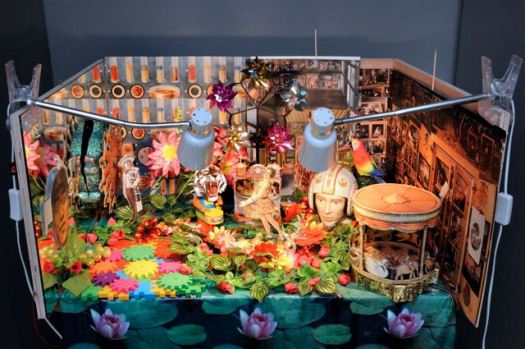
This rich profusion is a particular feature of two installations. Dina Goldstein‘s Wonderland is a bewitching stage set assembled from multi-colored paper cut-outs, originally prepared for an international festival of Puppet Theater. To the tinny sounds of an old love song, objects and figures drawn from circus and music hall sources of a bygone era, jerk into movement, twirl around, or hover in space. Above, a camera zooms in on specific details, including the silhouette of a figure rearranging the set.
And then there is Shay Id Aloni‘s Cabinet Magicis Cubiculum Curiositatibus: comprising a huge collection of skulls, bones and masks, and other macabre objects, some ready-made, some fashioned by him, mounted on shelves. On the wall behind, a painting of masked faces, (alongside others of no particular interest), reveal a major source of influence on Aloni’s work – the Belgian artist James Ensor (1860-1949) known for his depictions of masked or skull-like faces.
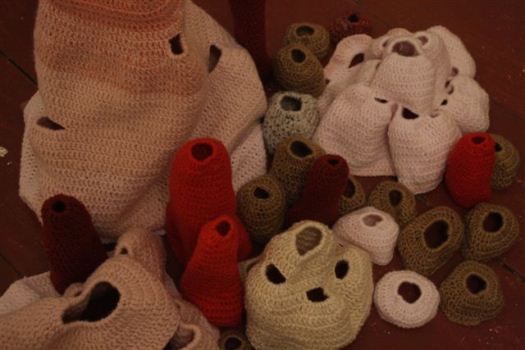
Blurring Nature’s boundaries between the real and artificial, the identifiable and the strange are many fascinating exhibits. Their presence recalls the fact that it was not uncommon to find fake objects among the contents of a Cabinet of Wonder. Holding the eye among this group of works is Alice Fleisher‘s Nest, an outsize piece woven from branches, wire and metal netting. Because of its size, this is a threatening object, negating the familiar associations of a nest as a place of warmth and security. Captivating for its delicacy, as well as for its use of unusual materials is Belle Shafir‘s wall piece Samsara, (a Sanskrit word referring to the cycle of life). Produced by crocheting and knotting horse-hair, it has the appearance of gossamer-fine netting within which tiny creatures are entangled. Notable too, is Asif Shwartz-Yasour‘s climbing and spreading wall plant fashioned from 100s of knitted balls of wool; a piece given sinister connotations through its title: Tumor.
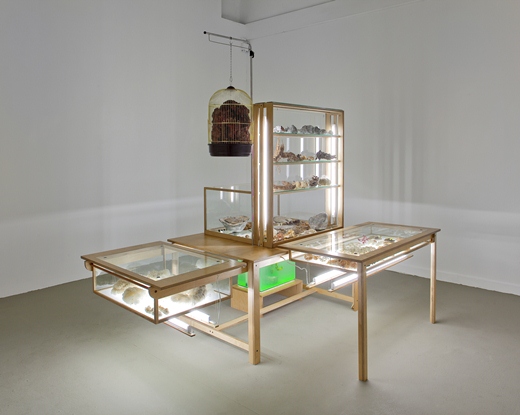
Tomer Sapir has tampered with Nature to produce the scores of intriguing found objects that make up his installation Research for the Full Crypto-Taxidermical Index (the title referring to the embalming of creatures that do not actually exist.) Meticulously arranged, each piece, whether a fossil, a sponge, a lump of mineral or the quill of a porcupine (to give just four examples) has been individually treated, coated with wax, latex, salts or other materials. The result is a unique body of work in which Nature and the Unnatural co-exist in harmony.
Variations on the theme of Memento Mori – a reminder of the inevitability of death – are the focus of a number of works of varying interest. Moving away from Maya Attoun‘s installation of multiple skulls fabricated from linoleum, one’s eye alighted on Michal Shamir‘s more subtle exhibit: a flock of ghostly white birds suspended from the ceiling. Frail and semi-transparent, they seem at vanishing point. Also of interest are Einat Arif-Galanti‘s deceptive photographs of decaying, half-eaten fruit and vegetables set alongside perfect looking specimens made from plastic. At first, one is inclined to see these objects as Memento Mori symbols as associated with the Golden Age of Dutch still-life painting, but apparently this is not her intention. A catalog text informs us that Arif-Galanti, through metaphors, is making a “humorous comment on contemporary society where people experience pressure to erase signs of ageing at all costs.”
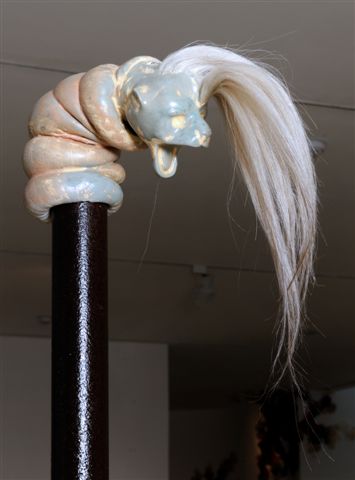
Ethnographic items pertaining to pagan beliefs and tribal customs were a feature of many Cabinets of Wonder. Karen Russo stays real with her documentary film about Externsteine, a mysterious rock formation in North-West Germany, a site deemed sacred by Himmler, and revered by neo-Pagans and various German Nationalist movements. Her camera follows the strange ceremonies enacted there, and records interviews with elderly people speak about the magic powers of this site. In contrast, Sharon Glazberg’s installation, a set of scepter-like objects set up a circle, suggests some fantasy ritual. Her raw materials are appealing: metal poles stuck into cement blocks, once employed as road signs. She has topped these with gargoyle-like faces fashioned from polymer plastics.
As the full title of this exhibition suggests, disillusionment may follow enchantment. And there are several pieces that have just this effect. Among them Shefi Blair‘s classical photograph of what appear to be softly tinted balloons hanging by cords. On closer inspection, one finds that one is looking at the suspended innards of a cow. Equally misleading are Ariela Padan‘s exquisite black and white photos (288 in number) of what appears to be a night sky. But in actuality her camera was focusing (over the course of a year) on the mouth of the Alexander River, a site which has won international prizes for the completion of a restoration project there. Ironically, what Padan’s recent photos reveal are blotches and splatters of industrial waste.
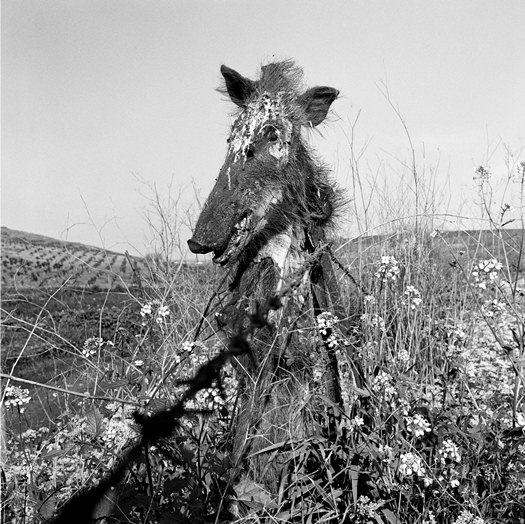
There is nothing enchanting about Guy Raz‘s photos taken of Wadi Es Sidr near his home kibbutz in the Jezre’el Valley, remembered from his childhood as a beauty spot. But, returning to this area after his army service, he found that it had become a garbage dump (now closed), and displayed within in it were the heads of wild boar mounted on metal spikes. These boars had been killed by kibbutz members and eaten at a festive meal. This pagan sight, and the reprehensible events that preceded it, raise serious moral, aesthetic and ecological issues, especially in a country where its citizens from early childhood have been taught to respect and protect Nature.
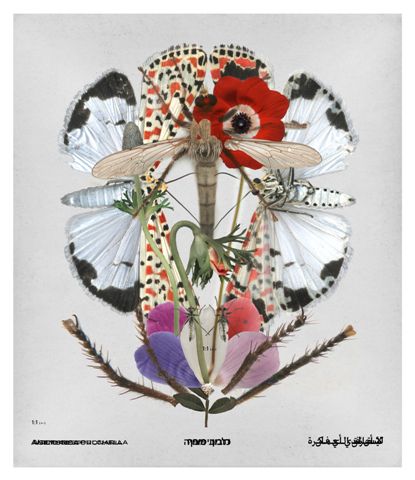
Eliezer Sonnenstein‘s altruistic project Insects and Plants in Israel aimed at reawakening the love of Nature in Israelis enables this review to conclude on a positive note. Utilizing sophisticated photo- technology, this artist is planning to publish an illustrated manual on Taxonomy – the science of naming and describing living organisms – in which local plants and insects will be depicted in high definition and minute detail. Picturesque examples of this work-in-progress are on display in this extra-ordinary exhibition.
Open till 29th December 2012. English online catalogue at http://www.herzliyamuseum.co.il/english/current-exhibition/link-current-exhibition
Herzliya Museum of Contemporary art, 4 Ha’banim St., Herzliya. Tel 09. 9500762





